York County Office of Emergency Management
On January 15, 2020, representatives of Crabtree, Rohrbaugh & Associates – Architects (CRA), were invited to the York County Office of Emergency Management in York, PA to discuss practical applications in safe school design. The focus of the presentation discussed strategies that promote nurturing learning environments where students feel safe, engaged and inclusive. In attendance were local law enforcement, first responders and school district / business administrators.
PROCESS
John A. Beddia, AIA, Managing Partner of CRA, stressed the importance of establishing a process early in the planning and design phase to identify the key stakeholders. “It’s important we change the approach of reviewing building designs prior to starting construction and bring together a collaborative group early to establish security expectations and goals.” This approach is supported through the implementation of Crime Prevention through Environmental Design (CPTED). Implementing CPTED principles aims to reduce victimization, deter offenders and build a sense of community to gain territorial control of areas to reduce the fear of crime.
PROTOCOL AND POLICY
The Act 44 Safety and Security Assessment Criteria, developed by the Pennsylvania Commission on Crime and Delinquency (PCCD), sets standards of safety practices related to school district policy, faculty and staff training, mental health services, and reducing physical vulnerabilities.
As planners and design professionals we focus on physical vulnerabilities. However, for any physical deterrent to be effective, active or passive, it must perform in concert with policy, procedures, and within the school district’s culture. At CRA we recognize that while standards of best practice for school safety are consistent, every school district and the law enforcement professionals, and first responders who serve them are unique.
Dr. Frederick Withum, the Director of Educational Planning at CRA stated, “When we work with our clients and are making these presentations our goal is not to promote a particular system or set of policies and procedures. Our goal is to help school districts identify how they can strive to assure that best practices in school safety work well for them. We feel that this is accomplished by promoting meaningful conversation in order to identify, prioritize, and incorporate cost-effective physical safety features, practices, and technologies into maintenance plans, facility upgrades, and new construction. When educators, facility directors, law enforcement, design professionals, and trusted stakeholders are at the table, difficult conversations become easier and the solutions fit the district best, are more consistently implemented and most important more effective.”
“Teaching and learning styles have continued to evolve and so must the architecture,” said John Beddia, “The level of desired security, financial capability and adaptability to existing buildings are all important variables in developing a holistic approach that makes sense. How each of these items are creatively implemented will define the architecture and support a facility that both look and feel like a welcoming school environment.”





